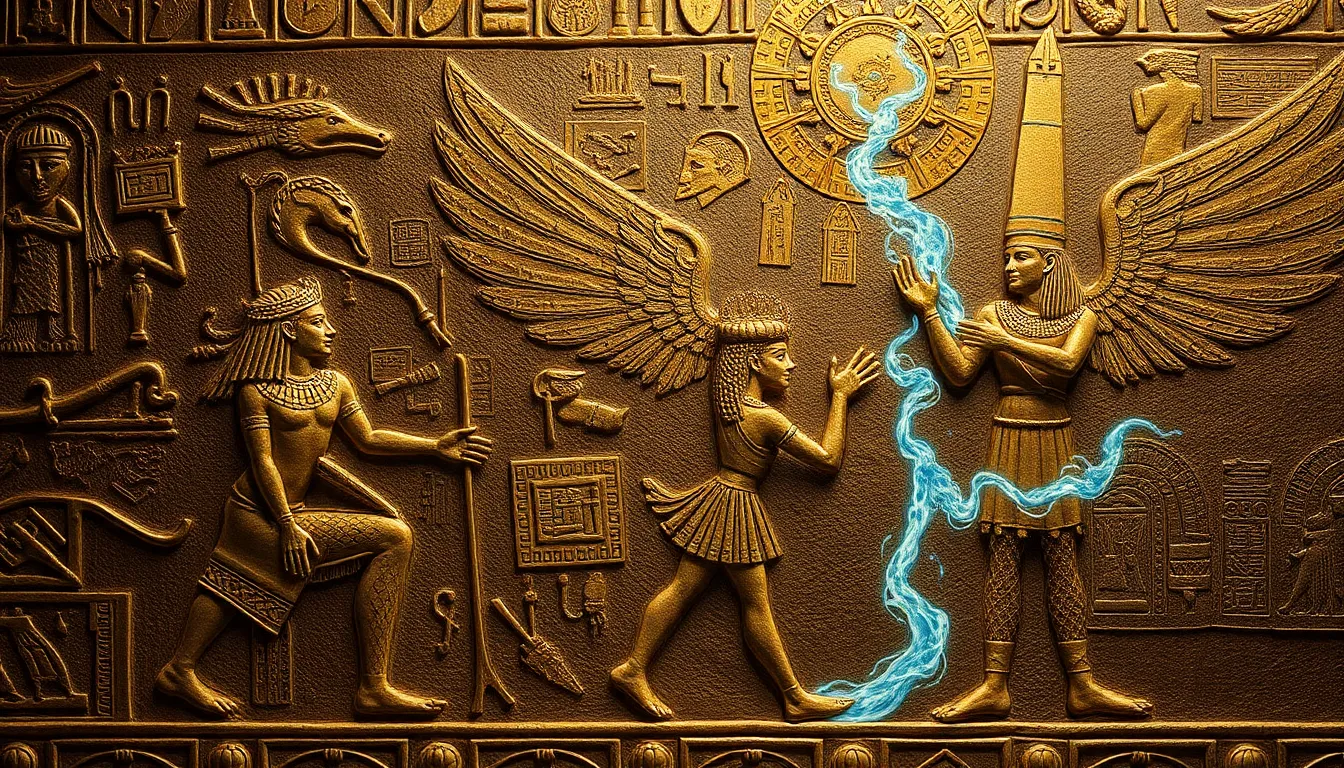The Connection Between Egyptian Mythology and Sacred Art
I. Introduction
Egyptian mythology is a rich tapestry of stories, beliefs, and deities that have shaped the culture and identity of ancient Egypt for millennia. It encompasses a wide range of gods and goddesses, each representing various aspects of life, nature, and the cosmos. The significance of these myths extends beyond mere storytelling; they serve as a framework for understanding existence and morality in ancient Egyptian society.
In tandem with mythology, sacred art played a vital role in ancient Egyptian culture. Art was not just a form of aesthetic expression; it was a manifestation of religious beliefs and practices. The purpose of this article is to explore the interrelationship between mythology and sacred art, highlighting how these two elements are woven together to create a deeper understanding of ancient Egyptian civilization.
II. The Role of Mythology in Ancient Egyptian Society
Mythology was central to the lives of ancient Egyptians, influencing their worldview and societal structure. The following aspects illustrate the importance of mythology in this ancient culture:
- Overview of key deities and their significance: Major deities such as Ra, Isis, Osiris, and Anubis were revered in various aspects of daily life, from agriculture to funerary practices. Each deity had specific roles and attributes, shaping the religious landscape of ancient Egypt.
- Myths as moral and ethical guides: Egyptian myths often conveyed important lessons about order, justice, and morality. They served to guide individuals in their actions and decisions, reinforcing societal norms.
- Influence of mythology on daily life and rituals: Mythological narratives were integral to religious rituals, ceremonies, and festivals, deeply embedding the divine into the fabric of everyday existence.
III. Sacred Art as a Reflection of Mythological Themes
Art in ancient Egypt was profoundly influenced by mythology, serving as a visual language that depicted divine stories and beliefs.
- Iconography in sacred art: The use of specific symbols and figures in art was meant to communicate religious ideas. For example, the ankh symbolized life, while the scarab represented rebirth and regeneration.
- Common mythological motifs in ancient art: Themes such as resurrection, creation, and the afterlife were prevalent in artistic representations, illustrating the interconnectedness of myth and art.
- The purpose of art in religious practices: Sacred art was created not only for aesthetic appeal but also to honor the gods, commemorate the dead, and facilitate communication between the divine and the mortal realms.
IV. Temples and Tombs: Artistic Expressions of Belief
The architectural and artistic endeavors of ancient Egyptians are vividly displayed in their temples and tombs, which served as profound expressions of their beliefs.
- The architectural significance of temples: Temples were designed as sacred spaces to honor the gods. Their intricate carvings and monumental sculptures often depicted mythological scenes and deities, reinforcing their religious significance.
- Tomb paintings and their connection to the afterlife: Tombs were adorned with paintings and inscriptions that illustrated the deceased’s journey to the afterlife, drawing heavily on mythological narratives to ensure a safe passage.
- The role of art in funerary practices: Art played a crucial role in funerary customs, with sculptures and wall art designed to protect and guide the dead in the afterlife.
V. Symbolism in Egyptian Art and its Mythological Roots
Understanding the symbolism in Egyptian art enhances the appreciation of its mythological connections. Key aspects include:
- Analysis of symbols: Symbols such as the ankh, scarab, and Eye of Horus carry deep meanings. The ankh represents life and immortality, while the scarab signifies transformation and protection.
- The meanings behind color and form in sacred art: Colors in ancient Egyptian art were not merely decorative; they held symbolic significance. For instance, green represented fertility and rebirth, while red symbolized chaos and disorder.
- How symbolism enhances the understanding of mythology: The use of symbols and colors helps convey complex mythological narratives, allowing viewers to grasp the underlying themes and messages easily.
VI. Case Studies: Notable Works of Sacred Art
Several remarkable works of sacred art exemplify the connection between Egyptian mythology and artistic expression:
- The Book of the Dead: This ancient text features illustrations that depict the journey of the soul through the afterlife, closely tied to mythological stories of Osiris and judgment.
- Statues of deities: Statues such as those of Isis and Horus serve as both artistic masterpieces and religious symbols, representing divine presence and protection.
- Wall reliefs in temples: Temples like Karnak and Luxor boast intricate wall reliefs that narrate mythological tales, showcasing the gods in various scenes of interaction with humanity.
VII. The Legacy of Egyptian Mythology in Sacred Art Today
The influence of Egyptian mythology and sacred art extends into contemporary culture, highlighting its enduring legacy:
- Influence on contemporary artists and art movements: Modern artists often draw inspiration from Egyptian themes, incorporating mythological elements into their work to explore identity and spirituality.
- Preservation of mythological themes in modern interpretations: Various art forms, including literature and cinema, continue to reference Egyptian mythology, ensuring its relevance in contemporary narratives.
- The continued relevance of Egyptian mythology in cultural expressions: Egyptian myths and symbols remain a source of fascination and inspiration, reflecting humanity’s ongoing quest for understanding the divine.
VIII. Conclusion
The interconnectedness of Egyptian mythology and sacred art is a testament to the depth and richness of ancient Egyptian culture. Through the exploration of deities, symbols, and artistic expressions, it becomes clear how these elements work in harmony to convey complex narratives and beliefs.
The enduring impact of Egyptian sacred art on our understanding of mythology is profound, offering insights into the values, fears, and aspirations of an ancient civilization. As we continue to study and preserve this rich cultural heritage, we ensure that the stories of the past remain alive, informing our present and future.




